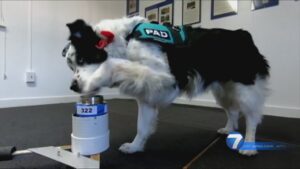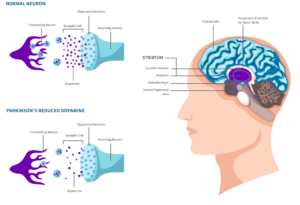The Fragrance of Parkinson’s: Olfactory Advances in Neurodegenerative Disease Diagnosis

Written by: Abhinav Anne
Parkinson’s disease, a common neurodegenerative disorder, affects over 10 million people worldwide. The disease is characterized by a variety of metabolic and genetic factors, including mitochondrial dysfunction and genetic mutations. Currently, diagnosis heavily relies on late-stage motor symptoms, emphasizing the need for early detection methods. Currently, innovative approaches are being utilized in the detection of Parkinson’s disease. Trained service dogs are being used to identify the unique scent associated with the condition, while olfactory tests, such as the University of Pennsylvania Smell Identification Test (UPSIT), provide a more clinical approach. This paper explores these causes and potential diagnostic tests, with a vision for future personalized treatments based on genetic and metabolic insights.
Parkinson’s Disease and Mitochondrial Dysfunction
Parkinson’s Disease, significantly the US population, with over 1 million Americans diagnosed as of 2023. Current diagnosis relies on motor symptoms, underscoring the need for early diagnosis to initiate treatments that slow disease progression and reduce symptom severity. Most patients start experiencing symptoms after age 50, with a higher prevalence in males. The prodromal stage, characterized by non-motor symptoms like hyposmia (the reduced ability to smell and detect odors), seborrhea (excessive oiliness and scaliness of the skin), and emotional disturbances, can last 12 to 14 years before progressing to motor difficulties. Initial motor symptoms include muscle rigidity, unsteady gait, resting tremors, bradykinesia, and poor coordination, which can worsen without intervention. These symptoms can be attributed to the lack of dopamine in the midbrain’s substantia nigra pars compacta and the ventral tegmental area.
Understanding the mechanisms underlying the development of Parkinson’s is crucial for specializing treatments to address specific molecular events. Specialized treatments have the potential to do more than just alleviate symptoms; understanding these mechanisms could even lead to the possibility of developing a cure.
One such mechanism involves a significant loss of dopamine production in the midbrain’s nigrostriatal pathway. Protein 53 (p53), a regulatory transcriptional protein involved in various cellular activities, plays a crucial role in this process. Encoded by the TP53 gene, p53 can induce apoptosis (programmed cell death) of dopaminergic neurons due to neurodegenerative stressors like oxidative stress. Neurons are particularly vulnerable to oxidative stress due to their high energy requirements and limited regenerative capacity (Sciacca, 2019). Activation of p53 can lead to cell death by altering the structure of the inner mitochondrial membrane and can also be triggered by alpha-synuclein protein aggregates in dopaminergic neurons (Figure 1). Alpha-synuclein protein aggregates refer to clumps or clusters of alpha-synuclein proteins that accumulate abnormally in the brain. Increased p53 levels have been observed in model organisms with Parkinson’s, indicating a correlation between p53 levels and neurodegeneration. Thus, p53’s role in inducing neuronal apoptosis and regulating cellular activities is significant in Parkinson’s development.
Figure 1
A Comparison of Neural Mechanisms in patients affected and not affected by Parkinson’s
Source: Neuronic.Online
Environmental Factors and Parkinson’s Disease
Parkinson’s disease often has a strong genetic basis, with inheritance patterns being either autosomal dominant or autosomal recessive. The first identified type of familial Parkinson’s was found to be autosomal dominant, caused by a point mutation in the alpha-synuclein gene. However, such point mutations are rare and are not typically responsible for Parkinson’s in most patients. The most common genetic cause usually lies in mutations in the leucine-rich repeat kinase 2 (LRRK2) gene on chromosome 12 (Figure 2). This gene codes for the protein dardarin, which is involved in phosphorylation (the process of adding a phosphate group to an organic group), controlling cellular processes by stimulating specific signal transduction pathways or preventing activity (Chen, 2023).
Figure 2
LRRK2 variants adversely regulate the composition of the gut microbiome, leading to Parkinson’s Disease
Source: Journal of Psychology
In addition to genetic predispositions, the development of Parkinson’s disease can be influenced by environmental conditions and lifestyle choices. Chronic alcohol abuse has been observed to induce mitochondrial apoptosis, where long-term alcohol consumption causes lipid peroxidation. Another case investigated the relationship between the chemical, trichloroethylene (TCE), commonly used as a solvent for industrial cleaning, and Parkinson’s development.
Olfaction
Hyposmia, a significant reduction in the perception of smell, can occur during illnesses like COVID-19 or with conditions such as Alzheimer’s. As individuals age, the olfactory system becomes less sensitive due to damage to the epithelium lining or mucus from the nasal cavity. In Parkinson’s, clumps of alpha-synuclein proteins called Lewy Bodies invade the brain regions that process smell, hindering information processing and transfer. Research has shown that smell tests, like the University of Pennsylvania Smell Identification Test, can accurately differentiate the olfactory performance of Parkinson’s patients from healthy individuals (Eleuteri, 2019). This suggests that non-motor symptoms like olfactory dysfunction can precede motor symptoms in Parkinson’s patients.
Olfaction & Diagnosis
Aside from hyposmia, Parkinson’s patients often produce a distinct “musky” scent due to an excess of sebum, an oily secretion on the skin produced by sebaceous glands. This phenomenon was first documented by Joy Milne, who noticed the unique scent on her husband 12 years before his Parkinson’s diagnosis (Doctors 2022). Various neuroendocrine and metabolic changes, such as elevated levels of androgen and prolactin, changes in plasma and serum, alterations in lipid composition, and fatty acid beta-oxidation influence the excess sebum secretion (Kwon, 2022).
This observation led to the development of a novel, noninvasive diagnostic approach that utilizes patient sebum samples. In a 2021 study by Uehara et al., this technique was used to identify over 100 expressed genes related to Parkinson’s disease in two cohorts, one diagnosed with Parkinson’s and one with healthy individuals. This innovative diagnostic method has the potential to revolutionize the way Parkinson’s is diagnosed leading to faster patient recovery and improved outcomes.
Interestingly, dogs, known for their exceptional olfactory abilities, could be trained to distinguish sebum samples from patients with a confirmed Parkinson’s diagnosis and those without the disease. Dogs have an estimated 100,000 olfactory receptors in their nasal cavities, allowing them to detect specific scents down to 5.0 to 0.005 microliters (Kwon, 2022). Similar to how service dogs can be trained to identify potential allergens in food samples, they could be trained to confirm the presence of Parkinson’s in a given sebum sample by giving a physical signal like a paw raise. This noninvasive diagnostic approach, potentially utilizing the extraordinary olfactory capabilities of dogs revolutionizes the way the disease is diagnosed and managed (Figure 3).
Figure 3

Dogs trained to detect Parkinson’s Disease
Source: The New York Times
Diagnostic techniques and treatments
Until an effective long-term treatment or cure for Parkinson’s is found, patients depend on various medical regimens and diagnostic techniques to manage symptoms and diagnose the disorder. Early diagnosis can enhance treatment efficacy and slow disease progression. Current diagnostic methods rely on family history, physical exams, and existing symptoms (Kouli, 2018). More accurate but invasive tests can identify α-synuclein-containing Lewy bodies, genetic abnormalities, and the presence of certain cerebrospinal fluid metabolites. DAT-SPECT imaging, a less invasive method, can detect dysfunctional dopaminergic neurons, potentially diagnosing Parkinson’s before motor symptoms appear, allowing for earlier treatment initiation (Akdemir, 2021). Treatment options include levodopa to restore dopamine levels, deep brain stimulation for emotional symptoms, and pallidotomy surgery for severe cases.
Conclusion
The potential of a noninvasive diagnostic test, leveraging a dog’s exceptional sense of smell, could revolutionize the treatment approach for Parkinson’s disease. This method relies on detecting the “musky” scent from the excess sebum secretion, a non-motor symptom present in the prodromal stage of Parkinson’s. Early diagnosis, before the onset of motor symptoms, can enhance treatment efficacy, slow disease progression, and alleviate chronic symptoms. In parallel, the use of olfactory tests such as the University of Pennsylvania Smell Identification Test (UPSIT) provides a more clinical approach to early detection. This research could significantly advance healthcare by paving the way for more effective and targeted treatment strategies for neurodegenerative diseases.
References and Sources
Akdemir, Ü. Ö., Bora Tokçaer, A., & Atay, L. Ö. (2021). Dopamine transporter SPECT imaging in Parkinson’s disease and parkinsonian disorders. Turkish journal of medical sciences. 51(2), 400–410. https://doi.org/10.3906/sag-2008-253
Chen, J. (2023). Study Uncovers Biological Mechanism Behind Loss of Smell in Parkinson’s Patients. Retrieved from https://medicine.yale.edu/news-article/new-study-uncovers-biological-mechanism-behind-loss-of-smell-in-parkinsons-patients/
Doctors, A. the. (2022). Sebum smell could be a biomarker for Parkinson’s disease. Retrieved from https://www.uclahealth.org/news/sebum-smell-could-be-a-biomarker-for-parkinsons-disease#:~:text=In%20addition%20to%20interfering%20with,in%20Scotland%20is%20among%20them.
Eleuteri, S., & Albanese, A. (2019). VPS35-Based Approach: A Potential Innovative Treatment in Parkinson’s Disease. Frontiers in Neurology. 10. https://doi.org/10.3389/fneur.2019.01272
Kouli, A., Torsney, K., & Kuan, W.-L. (2018). Parkinson’s Disease: Etiology, Neuropathology, and Pathogenesis (T. B. Stoker & J. C. Greenland, Eds.). PubMed; Codon Publications. https://www.ncbi.nlm.nih.gov/books/NBK536722/#
Kwon, D. (2022). A Supersmeller Can Detect the Scent of Parkinson’s, Leading to an Experimental Test for the Illness. Retrieved from https://www.scientificamerican.com/article/a-supersmeller-can-detect-the-scent-of-parkinsons-leading-to-an-experimental-test-for-the-illness/
Parkinson’s disease. (2023). Retrieved from https://www.mayoclinic.org/diseases-conditions/parkinsons-disease/symptoms-causes/syc-20376055#:~:text=Parkinson’s%20disease%20is%20a%20progressive,stiffness%20or%20slowing%20of%20movement.
Poewe W. (2019). Smelling Parkinson’s Disease: New Metabolomic Biomarker for PD. ACS central science, 5(4), 575–576. https://doi.org/10.1021/acscentsci.9b00319
Sciacca, S., Lynch, J., Davagnanam, I., & Barker, R. (2019). Midbrain, pons, and medulla: Anatomy and syndromes. Radiographics, 39(4), 1110–1125. https://doi.org/10.1148/rg.2019180126

